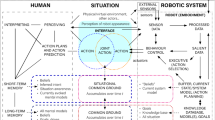Abstract
Our long-term goal is to develop robots as social mediators that can support human-human communication in remote interaction scenarios. This paper explores the effects of an autonomous robot on human-human remote communication and studies participants’ preferences in comparison with a communication system not involving robots. We developed a platform for remote human-human communication in the context of a collaborative computer game. The exploratory study involved twenty pairs of participants who communicated using video conference software. Participants expressed more social cues when using the robot and sharing of their game experiences with each other. However, analyses of the interactions of the participants with each other and with the robot show that it is difficult for participants to familiarise themselves quickly with the robot while they can perform the same task more efficiently with conventional devices. These issues need to be carefully considered and addressed when designing human-human remote communication systems with robots as social mediators.
Similar content being viewed by others
References
M. Folgheraiter, G. Giuseppina, L.V. Dario, A Glove Interface with Tactile Feeling Display for Humanoid Robotics and Virtual Reality Systems, Second International Conference on Informatics in Control, Automation and Robotics (ICINCO), Barcelona, Spain, 2005
T. Fong, I. Nourbakhsh, K. Dautenhahn, A Survey of Socially Interactive Robots, Robotics and Autonomous Systems, Volume 42,Issues 3–4, 2003, 143–166
F. Papadopoulos, K. Dautenhahn, W.C. Ho, M.L. Walters, AIBOCOM: Designing robot enhanced human-human remote communication technology, Proceedings of the Kansei Engineering and Emotion Research International Conference 2010 (KEER2010), 2–4 March 2010, Arts et Metiers ParisTech, Paris, France. ISBN: 978-4-9905104-0-4, 2010, 671–682.
N. Bos, J. Olson, D. Gergle, G. Olson, Z. Wright, Effects of Four Computer-Mediated Communications Channels on Trust Development, Proceedings of the SIGCHI conference on Human factors in computing systems: Changing our world, changing ourselves, 2002, 135–140
C. Breazeal, Social interactions in HRI: the robot view, Systems, Man, and Cybernetics, Part C: Applications and Reviews, IEEE Transactions, Volume: 34,Issue: 2, ISSN: 1094-6977, 2004, 181–186
K. Dautenhahn, Socially Intelligent Robots: Dimensions of Human — Robot Interaction, Philosophical Transactions of the Royal Society B: Biological Sciences 362(1480). 2007, 679–804
J.A. Meyer, A. Guillot, Simulation of Adaptive Behaviour in Animats: Review and Prospect, From Animals to Animals: Proceedings of the First International Conference on Simulation of Adaptive Behaviour, MA: MIT Press, 1990, 2–14
O. Avila-Garcia, L. Canamero, A Comparison of Behaviour Selection Architectures Using Viability Indicators, International Workshop on Biologically-Inspired Robotics: The Legacy of W. Grey Walter, 2002, 86–93
P.H. Kahn, N.G. Freier, B. Friedman, R.L. Severson, E.N. Feldman, Social And Moral Relationships with Robotic Others?, Robot and Human Interactive Communication, Roman, 13th IEEE International Workshop, ISBN: 0-7803-8570-5, 2004, 545–550
A. Kerepesi, E. Kubinyi, G.K. Jonson, M.S. Magnusson, A. Miklósi, Behavioural Comparison of Human-Animal (dog) and Human-Robot (AIBO) Interactions, Behavioural Processes, Volume 73,Issue 1, 2006, 92–99
J.K.S. Teh, A.D. Cheok, Y. Choi, C.F. Lasantha, R.L. Peiris, O.N.F. Newton, Huggy Pajama: A Mobile Parent and Child Hugging Communication System, Proceedings of the 7th international conference on Interaction design and children, Chicago, Illinois. 2008, 250–257
F.F. Mueller, F. Vetere, M.R. Gibbs, J. Kjeldskov, S. Pedell, S. Howard, Hug Over Distance, Conference on Human Factors in Computing Systems, ISBN:1-59593-002-7, 2005, 1673–1676
W. D. Stiehl, J. K. Lee, C. Breazeal The Design of a Semi-Autonomous Robot Avatar for Family Communication and Education, Proceedings of the IEEE International Symposium on Robot and Human Interactive Communication (RO-MAN), 2008
S.O. Adalgeirsson, C. Breazeal, MeBot: a robotic platform for socially embodied presence, HRI’ 10 Proceeding of the 5th ACM/IEEE international conference on Human-robot interaction, ACM New York, NY, USA, ISBN: 978-1-4244-4893-7, 2010
H. Kuzuoka, S. Oyama, K. Suzuki, K. Yamazaki, M. Mitsuishi, GestureMan: A Mobile Robot that Embodies a Remote Instructor’s Actions, Proceeding CSCW’ 00 Proceedings of the 2000 ACM conference on Computer supported cooperative work, 2000
V. Hayward, O.R. Astley, M. Cruz-Hernandez, D. Grant, G. Robles-De-La-Torre, Haptic interfaces and devices, The Mechanical Systems Handbook: Modeling, Measurement and Control, CRC Press, 2004
D. Archambault, R. Ossmann, T. Gaudy, K. Miesenberger, Computer Games and Visually Impaired People, Information Technologies for Visually Impaired People, Upgrade, 2007
S. Andrews, J. Mora, J. Lang, W.S. Lee, HaptiCast: A Physically-Based 3D Game with Haptic Feedback, Proceedings of The International Conference on the Future of Game Design and Technology (Future Play), 2006
D. Morris, N. Joshi, K. Salisbury, Haptic battle pong: high-degreeof-freedom haptics in a multiplayer gaming environment, Experimental Gameplay Workshop at GDC, 2004
A.J. Johansson, J. Linde, Using Simple Force Feedback Mechanisms to Visualize Structures by Haptics, Instrumentation and Measurement Technology Conference, Proceedings of the 16th IEEE, 1999
J. Baillie, Urbi: A universal language for robotic control. International Journal of Humanoid Robotics, 2004
T. Hartmann, C. Klimmt, Gender and Computer Games: Exploring Females’ Dislikes, Journal of Computer — Mediated Communication, Volume 11,Issue 4, 2006, 910–931
R.L. Slattery, What Does that Smile Mean? The Meaning of Nonverbal Behaviours in Social Interaction, Social Psychology Quarterly 65, 2002, 92–102
J. Cohen, ”A coefficient for agreement for nominal scales” in Education and Psychological Measurement. Vol. 20, 1960, 37–46
K. Gwet, ”Inter-Rater Reliability: Dependency on Trait Prevalence and Marginal Homogeneity”. Statistical Methods For Inter-Rater Reliability Assessment, 2002
K. Gwet, Computing inter-rater reliability and its variance in the presence of high agreement, British Journal of Mathematical and Statistical Psychology 61, 2008, 29–48
J. L. Fleiss, Statistical methods for rates and proportions. 2nd ed. (New York: John Wiley), 1981, 38–46
G.A. Miller, The magic number seven plus or minus two: some limits on our capacity to process information, Psychological Review 63(2), 1956, 81–97
F. Paas, A. Renkel, J. Sweller, Cognitive Load Theory: Instructional Implications of the Interaction between Information Structures and Cognitive Architecture, Instructional Science 32, 2004, 1–8
Author information
Authors and Affiliations
Corresponding author
About this article
Cite this article
Papadopoulos, F., Dautenhahn, K. & Ho, W.C. Exploring the use of robots as social mediators in a remote human-human collaborative communication experiment. Paladyn 3, 1–10 (2012). https://doi.org/10.2478/s13230-012-0018-z
Received:
Accepted:
Published:
Issue Date:
DOI: https://doi.org/10.2478/s13230-012-0018-z




